The Moon got bonked by a space rock during Sunday's total lunar eclipse. Plus, two supernovae are now visible for telescope users. Take a look!
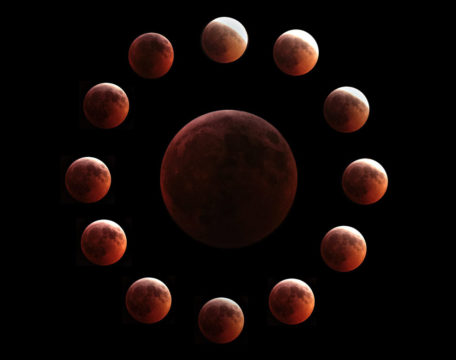
Andrealuna Pizzetti / Dario Caiumi / Mauro Facchini
As if the total lunar eclipse wasn't amazing enough, one binocular observer and more than a dozen people with still and video cameras recorded the split-second flash of a probable meteoroid impact on the Moon at the same time.
The flash appeared west of Mare Humorum (Sea of Moisture) southwest of the crater Byrgius at 4:41:38 UT (11:41 p.m. EST) only seconds into totality. We don't know how big the object was, though I've seen it described as possibly "the size of a football," but it slammed into the Moon within a few kilometers of latitude 29.47° south, longitude 67.77° west.
Will Young's 4K video of the impact taken from Claiborne Park in southeast Texas shows the impact at multiple frame rates so you can clearly see its evolution from bright to dim over 3–4 frames. He estimated it magnitude at ~7.
Lunar impacts occur all the time. What makes this event so unusual are the circumstances — it happened during a total eclipse watched by millions of people across half the Earth, making it the most widely observed and recorded lunar impact ever. According to David Dunham, who has photographed nine confirmed probable impact flashes, amateur George Varros recorded the only other possible eclipse flash on February 20, 2008. Dunham and Varros, along with other amateur astronomers, now routinely use video cameras to capture impacts, especially during major meteor showers, when the number of meteoroids in the Earth-Moon vicinity skyrockets.
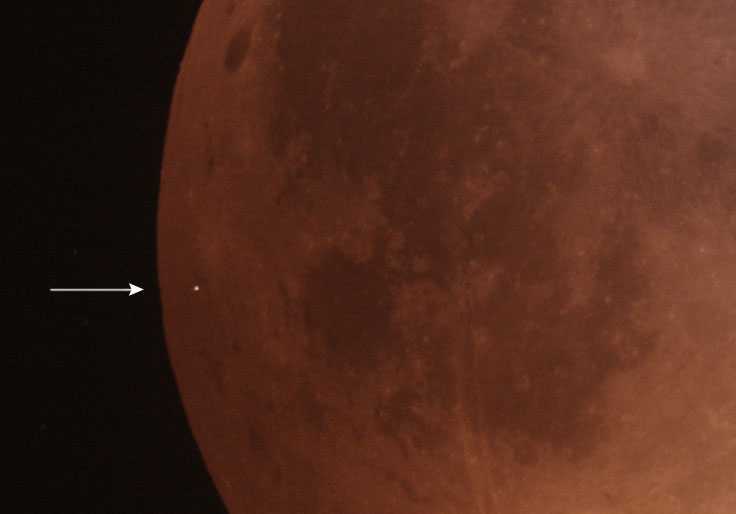
Christian Fröschlin
NASA is also keen on studying lunar impact rates. Its Meteoroid Environment Office (MEO), in collaboration with the Marshall Space Flight Center's Space Environments Team, uses twin 14-inch telescopes equipped with video cameras to keep watch for lunar flashes between new and first quarter and again between last quarter and new. Full and gibbous phases are avoided because there's little to no dark portion against which to see impacting meteoroids — except of course when the Moon is in total eclipse! Between 2005 and April 2018 the MEO recorded 435 flashes from meteoroid collisions. Most were bright enough to show in amateur scopes had someone kept a steady watch.
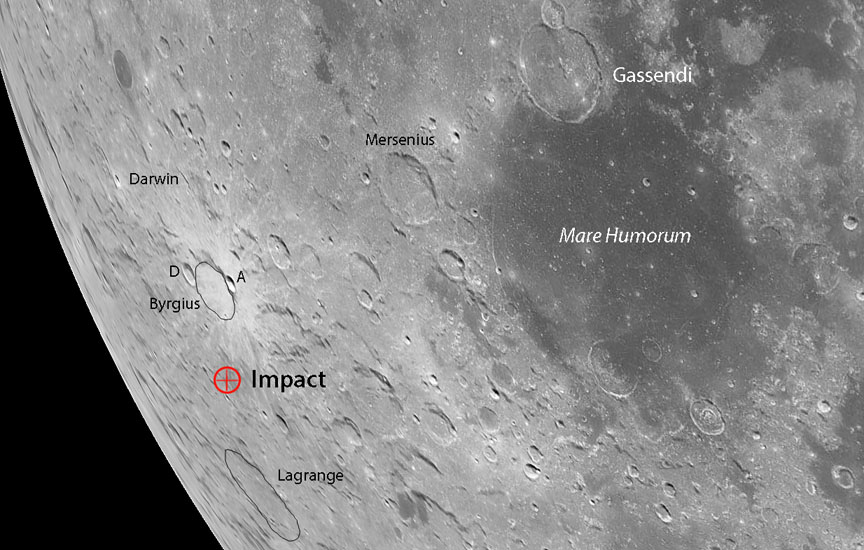
Virtual Moon Atlas with additions by the author
You might be skeptical of claims that the eclipse flasher was the real thing and not a pixel error on a camera chip, glint from an Earth-orbiting satellite, cosmic ray hit, or even a head-on meteor burning up in Earth's atmosphere. We can rule out all four in one fell swoop: multiple observers saw or recorded the flash from widely-separated locations at the same time and at the same exact spot on the Moon. Nothing local about it — the event occurred at the Moon.
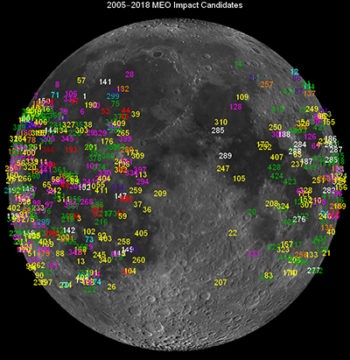
NASA / MEO
According to the MEO, about 33 metric tons (73,000 pounds) of meteoric material pelts Earth every day, nearly all of which burns up harmlessly in the atmosphere. A steady stream of space grit likewise slams into the Moon, but with little to no atmosphere to resist, it strikes the surface and vaporizes in a flash of light and heat. Speeds of incoming meteoroids range from 20 to more than 72 kilometers per second (45,000–160,000 mph), so even small rocks can pack a wallop. A meteoroid weighing as much as a holiday turkey (~5 kilograms) will excavate a crater over 9 meters across.
Will we be able to spot the impact scar or crater from Earth? Chances are slim as it's probably too small; it doesn't help that it occurred so close to the lunar limb, where everything gets scrunched (foreshortened) because of perspective. But it might be possible for NASA's Lunar Reconnaissance Orbiter to spy the fresh impact with its associated debris apron provided we can pin down the position.
In this video taken by the Griffith Observatory during the total lunar eclipse on January 20, 2019, the flash appears at 3:43:11. It looks just like a flashbulb going off.
Like me you're probably kicking yourself that you weren't staring at the Moon in binoculars or a telescope during the first minutes of totality. When the flash occurred I was either helping someone line up their phone to photograph the red Moon or maybe just in the act of lifting a pair binoculars to my eyes.
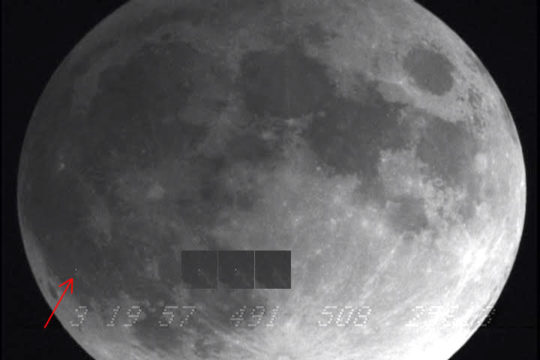
George Varros
If you're interested in hunting for meteoroid flashes yourself, you'll need a moderate-sized telescope, a sensitive black-and-white video camera, and software to record the video to your computer. You'll also want to download a free copy of LunarScan (Windows) to search the video for impact flashes. Most hits appear on just a single video frame for a duration of one-thirtieth of a second or less. The search software eliminates the tedium of watching long videos plus it will pick up the fainter flashes.
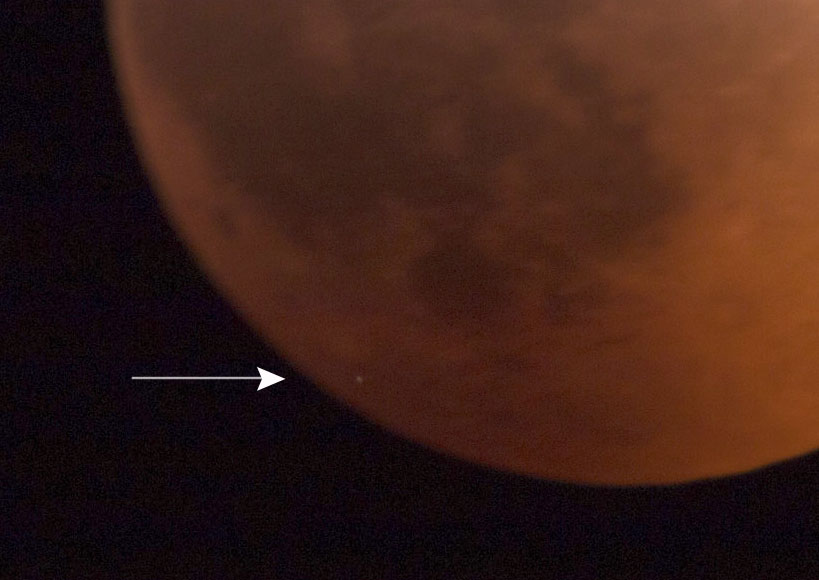
Sean Walker
Supernovae flashes, too!
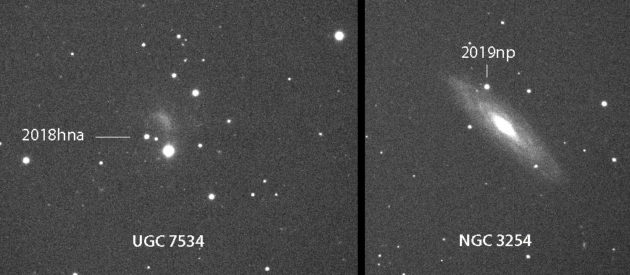
Koichi Itagaki
But that's not all that's been flashing lately. If you're a supernova freak like I am, there's great news. Two relatively bright exploding stars are now in view in the evening sky. With the Moon departing, hopefully we'll get a look at these incredibly powerful blasts masquerading as pinpoints of light in their host galaxies. Both were discovered by Koichi Itagaki, Japan's most prolific supernova hunter with well over 80 discoveries to his name. Supernova 2018hna appeared in the faint galaxy UGC 7534 on October 22, 2018, and took a long time to rise to its current magnitude of ~14. It's a Type II object involving the catastrophic collapse of a supergiant star at the end of its fuel supply.
Supernova 2019np in NGC 3254 in Leo Minor is a more recent find and easy to spot in 8-inch and larger telescopes at its current magnitude of 13.6. This Type Ia supernova started with a white dwarf star in binary system that accreted enough material from its companion to collapse, heat up, and explosively burn. Type Ia supernovae typically become about 5 billion times brighter than the Sun.
I haven't seen 2019np yet but did view 2018hna a week ago, when it was easily visible at 142× in my 15-inch Dob. The host galaxy is faint — just a misty presence — but the supernova quite plain.
 9
9









Comments
Rod
January 23, 2019 at 1:14 pm
Bob, "The flash appeared west of Mare Humorum (Sea of Moisture) southwest of the crater Byrgius at 4:41:38 UT (11:41 p.m. EST) only seconds into totality." Thanks for reporting the time of this flash (did not see in other reports). I was looking at M44 in Cancer with my binoculars so just missed it. I am happy to report I did observe one meteor flash by just before mid-eclipse time. "I observed one meteor flash by south of the Moon near mid-eclipse. 0008 EST (0508 UT), about 2nd magnitude moving towards Leo."
You must be logged in to post a comment.
Bob KingPost Author
January 23, 2019 at 5:49 pm
Excellent, Rod. You got a bonus, too, just a little closer to home 🙂
You must be logged in to post a comment.
Tom-Reiland
January 23, 2019 at 3:18 pm
Bob, I was able to observe the SN in UGC 7534 the night after Christmas using the 21" at Wagman Obs. I haven't had a chance to look at it since then. I'm waiting for the Moon to get out of the sky and a clear night or two to try to locate the SN in NGC 3254. If I do, it will be the 107 SN that I've seen, starting with the one that Gus Johnson, a fellow member of the AAAP (Pittsburgh) who lived in Deep Creek Maryland, discovered the SN in M100 in April of 1979. He was only the third amateur astronomer to visually discover a SN at that time. He inspired me, and others, to start looking for them. I don't know what happened to him. I've tried to find out, but we lost contact with him several years ago.
Keep the informative posts coming.
You must be logged in to post a comment.
Bob KingPost Author
January 23, 2019 at 5:48 pm
I'm with you, Tom — eager to see the NGC 3254 SN in a night or two after the moon's out of the way. It looks like an easy one clear and clean of the nucleus in a relatively bright galaxy.
You must be logged in to post a comment.
Bob KingPost Author
January 23, 2019 at 5:59 pm
Thank you so much, Kenneth for your observation. That makes at least two people who saw it visually. Congratulations!
You must be logged in to post a comment.
skristof
January 25, 2019 at 4:50 pm
Why was the flash so bright? If the material kicked up from the surface is just reflecting sunlight, then shouldn't it be in Earth's shadow and dim red like the rest of the moon? Or is the material heated enough on impact to be incandescent?
You must be logged in to post a comment.
Bob KingPost Author
January 25, 2019 at 4:56 pm
Hi skristof,
Thanks for asking. The flash is not from the material that's excavated but from the energy of impact. The meteoroid's kinetic energy (energy contained in its speed and mass) is turned into an explosion and a sudden burst of light at the site of impact.
You must be logged in to post a comment.
Kenneth Schroeder
January 25, 2019 at 9:20 pm
REPORT OF VISUAL REAL TIME OBSERVATION OF LUNAR ECLIPSE IMPACT
I observed this lunar meteoroid impact visually, in real time, using a pair of hand held Canon 10x42 image stabilized binoculars. I was observing from Auburn, WA, USA from a covered balcony. Partial light clouds were present during the early eclipse but skies had cleared by the time of impact at 8:41pm PST on 1/20/2019. The moon was at an approximate altitude of 38° with no obstructions.
Visually, the flash was extremely brief, maybe 2/10 second and a pinpoint of white light. The flash was bright enough in binoculars to immediately catch my attention. There was no hesitation or waffling as to what the flash was and I thought "meteor” instantly. The Canon binoculars have a field of view of 6.5° so the full lunar disc was visible. My view at impact was on the center of the moon so the flash appeared almost directly down (vertical) in my field of view very close the lunar edge which was in full shadow. The impact was not in my visual blind spot which might have prevented the sighting. I continued to look for more flashes with the binoculars for about one minute but none were evident.
During the five minutes before impact I had a Swarovski 20x-60x ATS 65mm spotting scope coupled to my Samsung Galaxy S8 phone. The phone camera was taking time-lapse images every 5 seconds. About one minute after the impact I removed the camera to scan with the scope at the location of the impact flash…but saw nothing unusual. I then up-loaded the frames from the camera to my desktop computer but, unfortunately, the time-lapse frames did not show the impact flash.
It was on Tuesday 1/22/2019 that I saw the first online recorded videos that showed the impact flash. Using those images of the lunar disc I confirmed that the flash location matched the location that I observed in real time. What a surprise to see my visual sighting verified by a video! I have watched several of the recorded videos and still photos and believe that my visual sighting appeared to be even brighter relative to the shadowed disc than the images show. In fact, I have not ruled out the possibility that I might have seen the impact flash as a naked eye observation. I still plan to try to estimate the visual magnitude to see if a naked eye observation might have been possible.
Here is a small amount of background information. I have been an amateur astronomer and naturalist for over 50 years. I recently retired from an academic career as a Professor of Engineering/Mathematics. Even though I am now a senior citizen I still have extremely rare visual acuity better than 20/10. I saw this flash with absolute, 100% certainty and will always remember it!
My understanding is that this is an extremely rare sighting of a real time meteoroid impact on the moon that was verified using video. The only other one I am aware of is by Brian Cudnik in 1999 seen during a gibbous moon phase that was verified by David Dunham. It is even possible that my real time visual sighting of an impact during a total lunar eclipse may be unique.
There are a few other circumstances to this observation that may be interesting to your readers if you decide to include my observation in a future article.
Thank you,
Kenneth Schroeder
Auburn, WA
[email protected]
253-939-7470
You must be logged in to post a comment.
Tom-Reiland
January 25, 2019 at 10:50 pm
I was able to observe SN2019np this evening. The conditions were fair at best, with the temperature dropping from 15 to 12 degrees F with moderate to gusting winds. The sky was fair with below average contrast. I viewed the SN before I saw the nucleus of the galaxy, NGC 3254. This was between 01:14 to 1:20 UT 1/26/19. I used 127X and 282X on the 21" Reflector. It was hard to estimate the magnitude because I was observing it between 15 to 20 degrees above the Eastern (ENE) horizon. Eventually, I put it at between 13.2 and 13.5. There were clouds on the southern and western horizons, so I started to close the observatory at 8:40 PM. Glad I made the effort. The local forecast for the next week to 10 nights in Western Pa is not conducive for observing. I'm getting too old for observing on these bitter cold nights. I'm ready for Spring.
You must be logged in to post a comment.
You must be logged in to post a comment.